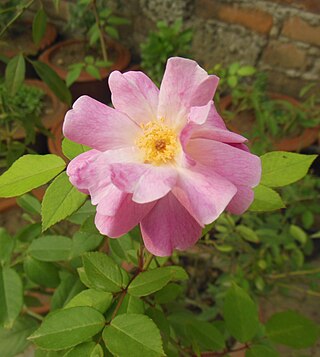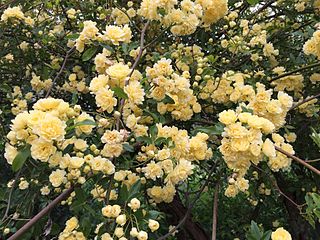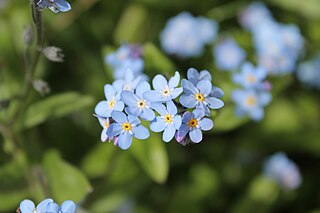
A rose is either a woody perennial flowering plant of the genus Rosa, in the family Rosaceae, or the flower it bears. There are over three hundred species and tens of thousands of cultivars. They form a group of plants that can be erect shrubs, climbing, or trailing, with stems that are often armed with sharp prickles. Their flowers vary in size and shape and are usually large and showy, in colours ranging from white through yellows and reds. Most species are native to Asia, with smaller numbers native to Europe, North America, and northwestern Africa. Species, cultivars and hybrids are all widely grown for their beauty and often are fragrant. Roses have acquired cultural significance in many societies. Rose plants range in size from compact, miniature roses, to climbers that can reach seven meters in height. Different species hybridize easily, and this has been used in the development of the wide range of garden roses.

Rosa rugosa is a species of rose native to eastern Asia, in northeastern China, Japan, Korea and southeastern Siberia, where it grows on beach coasts, often on sand dunes. It should not be confused with Rosa multiflora, which is also known as "Japanese rose". The Latin word "rugosa" means "wrinkled", referring to the wrinkled leaves.

Rosa multiflora — is a species of rose known commonly as multiflora rose, baby rose, Japanese rose, many-flowered rose, seven-sisters rose, Eijitsu rose and rambler rose. It is native to eastern Asia, in China, Japan, and Korea. It should not be confused with Rosa rugosa, which is also known as "Japanese rose", or with polyantha roses which are garden cultivars derived from hybrids of R. multiflora. It was introduced to North America, where it is regarded as an invasive species.

Hibiscus rosa-sinensis, known colloquially as Chinese hibiscus, China rose, Hawaiian hibiscus, rose mallow and shoeblack plant, is a species of tropical hibiscus, a flowering plant in the Hibisceae tribe of the family Malvaceae. It is widely cultivated as an ornamental plant in the tropics and subtropics, but its native range is Vanuatu.

Rosa glauca, the red-leaved rose or redleaf rose, is a species of rose native to the mountains of central and southern Europe, from the Spanish Pyrenees east to Bulgaria, and north to Germany and Poland. It is also found as an introduced species as far north as Scandinavia and Finland.

Rosa rubiginosa is a species of rose native to Europe and western Asia.

Rosa gallica, the Gallic rose, French rose, or rose of Provins, is a species of flowering plant in the rose family, native to southern and central Europe eastwards to Turkey and the Caucasus. Rosa gallica was one of the first species of rose to be cultivated in central Europe. It is a parent of several important cultivars.

Rosa banksiae, common names Lady Banks' rose, or just Banks' rose, is a species of flowering plant in the rose family, native to central and western China, in the provinces of Gansu, Guizhou, Henan, Hubei, Jiangsu, Sichuan and Yunnan, at altitudes of 500–2,200 m (1,640–7,218 ft). The rose is named for Dorothea Lady Banks, the wife of the botanist Sir Joseph Banks.

Rosa 'Harison's Yellow', also known as R. × harisonii, the Oregon Trail Rose or the Yellow Rose of Texas, is a rose cultivar which originated as a chance hybrid in the early 19th century. It probably is a seedling of Rosa foetida and Rosa pimpinellifolia. The cultivar first bloomed at the suburban villa of George Folliott Harison, attorney, between 8th and 9th Avenues on 32nd Street, north of New York City. The site of Harison's villa is now just south of the present General Post Office. The nurseryman William Prince of Flushing, Long Island took cuttings and marketed the rose in 1830. 'Harison's Yellow' is naturalized at abandoned house sites through the west and is found as a feral rose along the Oregon Trail.

Geranium maculatum, the wild geranium, spotted geranium, or wood geranium, is a perennial plant native to woodland in eastern North America, from southern Manitoba and southwestern Quebec south to Alabama and Georgia and west to Oklahoma and South Dakota.

Myosotis sylvatica, the wood forget-me-not or woodland forget-me-not, is a species of flowering plant in the family Boraginaceae, native to Europe. This spring-flowering plant and its cultivars, typically with blue flowers, are the familiar forget-me-nots of gardens.

Rosa nutkana, the Nootka rose, bristly rose, or wild rose is a 0.6–3.0-metre-tall (2–10-foot) perennial shrub in the rose family (Rosaceae).

Rosa acicularis is a flowering plant in the Rosaceae family. It is commonly known as the prickly wild rose, prickly rose, bristly rose, wild rose or Arctic rose. It is a species of wild rose with a Holarctic distribution in northern regions of Asia, Europe, and North America.

Rosa minutifolia is a species in the genus Rosa. It is also known by the common names Baja rose, Baja littleleaf rose, and small-leaved rose.

Garden roses are predominantly hybrid roses that are grown as ornamental plants in private or public gardens. They are one of the most popular and widely cultivated groups of flowering plants, especially in temperate climates. An enormous number of garden cultivars have been produced, especially over the last two centuries, though roses have been known in the garden for millennia beforehand. While most garden roses are grown for their flowers, often in dedicated rose gardens, some are also valued for other reasons, such as having ornamental fruit, providing ground cover, or for hedging.

Rosa 'Nevada' is a white climbing rose cultivar developed by Pedro Dot in Spain in 1927. It is one of his most successful creations and is named for its colour, as nevada is the Spanish word for "snowy". Its parentage was long under discussion, as Dot introduced the cultivar as a hybrid moyesii, but the cultivar's round, black hips point to its R. pimpinellifolia-parentage. It is probably a cross between Dot's pink hybrid tea 'La Giralda' and the wild rose species Rosa pimpinellifolia var. altaica, but is sometimes still described as a hybrid moyesii.

Rosa 'Arthur Bell',, is a yellow rose cultivar, bred by Sam McGredy IV in Northern Ireland in 1964. The rose has won numerous awards, and is popular in England and Northern Europe.

Rosa 'Cécile Brünner', also known as 'Mlle Cécile Brünner', 'Sweetheart Rose', 'Malteser Rose', or 'Mignon', is a light pink polyantha rose bred in France by Marie Ducher and introduced by her son-in-law, Joseph Pernet-Ducher in 1881. Its parents were a double-flowered R. multiflora and a hybrid tea rose, either 'Souvenir d'un Ami' or a seedling of 'Mme de Tartas'. It is not clear if the rose was named after the sister (1853–1927) or daughter of Ulrich Brunner fils.

Rosa 'Blush Noisette' is a light pink Noisette rose introduced by Phillipe Noisette around 1815. It was one of the first Noisette roses, and over time has been called by a multitude of names, including Rosa × noisettiana, 'Rosier de Philippe Noisette', 'Noisette de l'Inde, 'Blush Cluster', or 'Noisette Carnée'. According to the RHS Encyclopedia of Roses, the cultivar is mostly called 'Blush Noisette' in America, and otherwise known as 'Noisette Carnée'. 'Blush Noisette' arose as a seedling from the light pink rose hybrid 'Champney's Pink Cluster', introduced by Champneys around 1811, and was the first frost-hardy climber flowering repeatedly, giving the cultivar importance as a parent rose.

Rosa 'Queen Elizabeth' is a pink Grandiflora rose cultivar, bred by rose grower, Dr. Walter Lammerts in the United States in 1954. The rose variety is very popular worldwide and has won numerous awards, including "World's Favorite Rose", (1979).
























